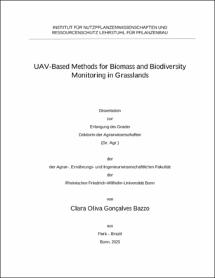UAV-Based Methods for Biomass and Biodiversity Monitoring in Grasslands
UAV-Based Methods for Biomass and Biodiversity Monitoring in Grasslands
| dc.contributor.advisor | Gaiser, Thomas | |
| dc.contributor.author | Gonçalves Bazzo, Clara Oliva | |
| dc.date.accessioned | 2025-06-03T08:04:32Z | |
| dc.date.issued | 03.06.2025 | |
| dc.identifier.uri | https://hdl.handle.net/20.500.11811/13115 | |
| dc.description.abstract | Grasslands are critical ecosystems that provide essential ecological services, including biodiversity conservation, carbon sequestration, water regulation, soil stabilization, and habitat provision for wildlife. However, these ecosystems are increasingly threatened by land-use intensification, climate change, and biodiversity loss. This thesis investigates the application of Unmanned Aerial Vehicles (UAVs) and advanced data integration techniques to improve the monitoring and management of grasslands, with a focus on biomass estimation and biodiversity assessment under varying management practices. The systematic review presented in this thesis consolidates current methodologies for UAV-based biomass estimation, identifying key strengths, limitations, and emerging trends. It emphasizes the growing potential of integrating structural, spectral, and textural image data to address the challenges posed by grassland heterogeneity and complex vegetation dynamics. This review provides a comprehensive framework for designing UAV-based monitoring systems and serves as a foundation for the experimental studies conducted in subsequent chapters. Experimental field studies were conducted over three years in a managed wet grassland to monitor key ecosystem services, specifically biomass production and biodiversity, under different cutting management regimes. The research demonstrated that disturbances such as molehills and lodging can impact the relationship between canopy height and biomass, leading to potential inaccuracies in UAV-derived models. Following this, the study explored the integration of UAV-derived features—structural (e.g., canopy height), spectral (e.g., vegetation indices), and textural metrics—to improve biomass estimation accuracy. By combining these features, the research achieved improved predictive accuracy, highlighting the utility of UAV-derived multi-dimensional data in capturing the complexity of grassland ecosystems. Biodiversity assessment was another key focus of this thesis. The study investigated the estimation of plant species richness in managed grasslands using UAV-derived data, focusing on the influence of cutting regimes and spatial heterogeneity on prediction accuracy. The results demonstrated that integrating structural, spectral, and texture features of the grassland extracted from a UAV-based multi-spectral sensor improved the ability to estimate species richness, particularly in systems with high cutting frequencies. Texture features of the grassland, in particular, provided valuable insights into the spatial variability of vegetation structure, enabling more accurate predictions in areas with more intensive management. While the findings demonstrate the potential of UAV technologies for ecological monitoring, several challenges remain. These include the complexity of data processing workflows, the need for precise calibration and validation, and logistical constraints associated with field operations. Overcoming these challenges will require the advancements in sensor technologies, more accessible machine learning tools, and scalable frameworks to broaden the application of UAV-based monitoring across diverse grassland ecosystems. This thesis provides a comprehensive framework for integrating UAV-derived data into grassland monitoring and management, offering valuable insights for both scientific research and practical applications. By addressing the challenges identified, future research can refine these approaches, supporting the conservation and sustainable management of grasslands under changing environmental conditions. | en |
| dc.language.iso | eng | |
| dc.rights | In Copyright | |
| dc.rights.uri | http://rightsstatements.org/vocab/InC/1.0/ | |
| dc.subject.ddc | 630 Landwirtschaft, Veterinärmedizin | |
| dc.title | UAV-Based Methods for Biomass and Biodiversity Monitoring in Grasslands | |
| dc.type | Dissertation oder Habilitation | |
| dc.publisher.name | Universitäts- und Landesbibliothek Bonn | |
| dc.publisher.location | Bonn | |
| dc.rights.accessRights | embargoedAccess | |
| dc.date.embargoEndDate | 01.12.2025 | |
| dc.identifier.urn | https://nbn-resolving.org/urn:nbn:de:hbz:5-82870 | |
| dc.relation.doi | https://doi.org/10.3390/rs15030639 | |
| dc.relation.doi | https://doi.org/10.1007/s41064-024-00322-x | |
| dc.relation.doi | https://doi.org/10.1016/J.ECOINF.2024.102813 | |
| ulbbn.pubtype | Erstveröffentlichung | |
| ulbbnediss.affiliation.name | Rheinische Friedrich-Wilhelms-Universität Bonn | |
| ulbbnediss.affiliation.location | Bonn | |
| ulbbnediss.thesis.level | Dissertation | |
| ulbbnediss.dissID | 8287 | |
| ulbbnediss.date.accepted | 10.04.2025 | |
| ulbbnediss.institute | Agrar-, Ernährungs- und Ingenieurwissenschaftliche Fakultät : Institut für Nutzpflanzenwissenschaften und Ressourcenschutz (INRES) | |
| ulbbnediss.fakultaet | Agrar-, Ernährungs- und Ingenieurwissenschaftliche Fakultät | |
| dc.contributor.coReferee | Döring, Thomas | |
| ulbbnediss.contributor.orcid | https://orcid.org/0000-0001-7393-9877 |
Dateien zu dieser Ressource

Dieses Dokument ist zur Zeit gesperrt.
Das Dokument erscheint in:
-
E-Dissertationen (1118)



